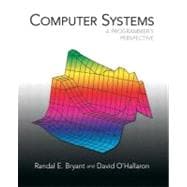
(NOTE: Each chapter concludes with Summary.)
Preface.
1. A Tour of Computer Systems.
I. PROGRAM STRUCTURE AND EXECUTION.
II. RUNNING PROGRAMS ON A SYSTEM.
III. INTERACTION AND COMMUNICATION BETWEEN PROGRAMS.
The New copy of this book will include any supplemental materials advertised. Please check the title of the book to determine if it should include any access cards, study guides, lab manuals, CDs, etc.
The Used, Rental and eBook copies of this book are not guaranteed to include any supplemental materials. Typically, only the book itself is included. This is true even if the title states it includes any access cards, study guides, lab manuals, CDs, etc.